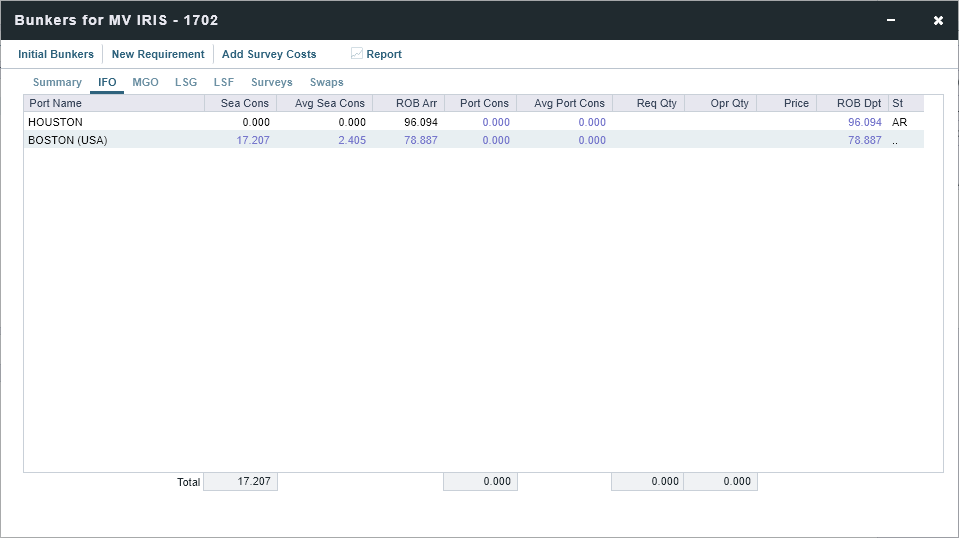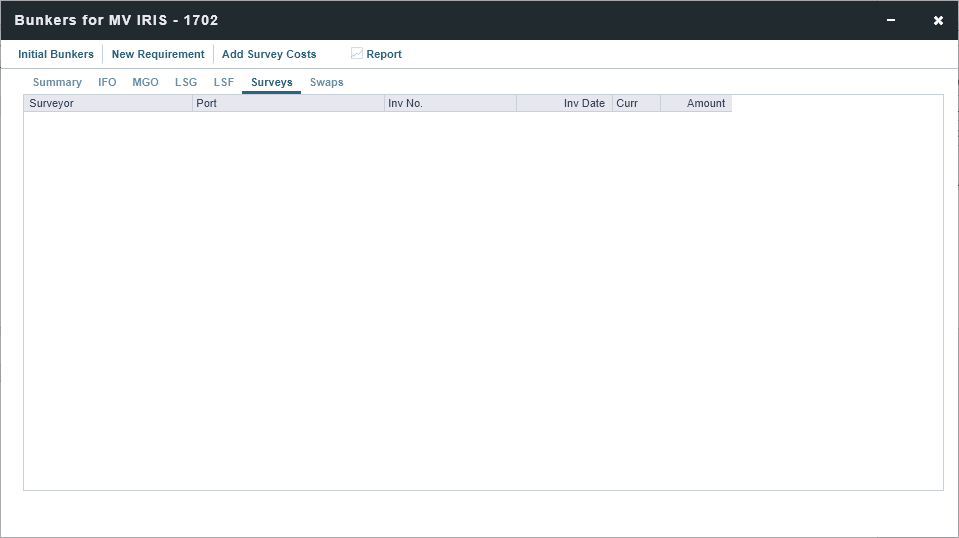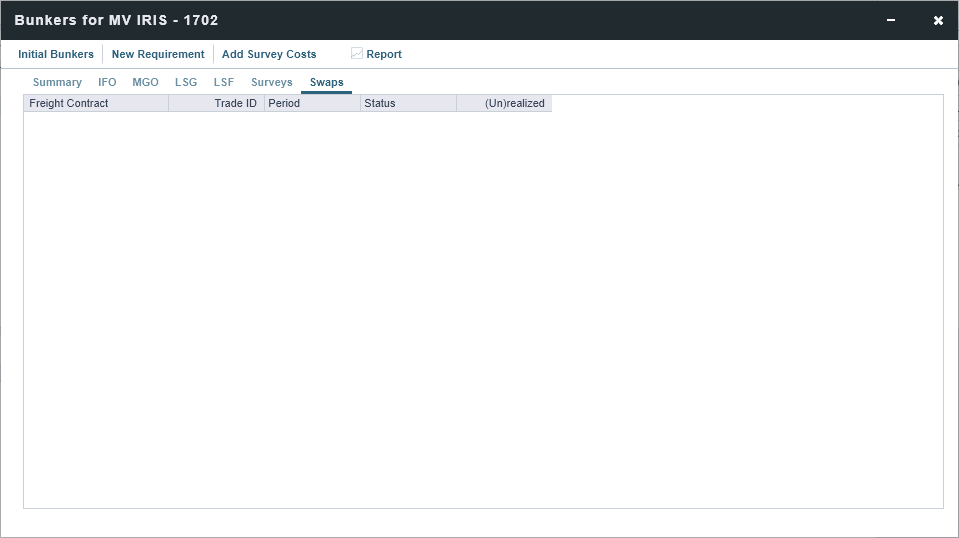IMOS - Voyage Bunkers
Home > Operations > Voyage Bunkers
If you have purchased the separate Bunkering module, see Bunkering rather than this section.
On the Voyage Bunkers form, you can plan forward bunkerings and follow the progress of your Bunker Requirements.
Multiple types, or grades, of fuel can be set up on the Fuel/Lube Types Term List in the Data Center. For each vessel, you can track up to five fuel types.
The Bunker Calculation Method is the method of valuing the fuel onboard; it determines how the cost of fuel is allocated to voyages.
To work with bunkers for the voyage, on the Voyage Manager toolbar, click Bunkers and then click Voyage Bunkers.
Summary Tab
Received quantities appear on the Summary tab after they are entered in Port Activities.
To bind a Bunker Invoice to the voyage, in the Bunker Liftings grid, the S check box must be selected.

Note: End Qty and End Prc will be imported to the next voyage as Initial Quantity and Price provided that this is a subsequent voyage. For example, if a vessel sails a TCTO voyage (1), a RELT voyage (2), and a TCTO voyage (3), the initial bunker quantity and price on the last voyage will be taken from the TCO contract (voyage 3) rather than from the End Qty and Price of the TCTO (voyage 1) because there are no bunkers recorded on the RELT voyage, which happens in between the two TC voyages. In order to commence a voyage .1MT of a any fuel type is required.
Fuel Zones
For voyages that are not already using Fuel Zones to calculate bunker consumption and have unsailed ports, a Use Fuel Zones button appears in the bottom right corner. To recalculate estimated bunker consumption and cost based on information entered in Fuel Zones in the Data Center, click Use Fuel Zones.
If you have configured a Fuel Zone Set, you can select it, rather than the Default set, at the bottom of this form.
Use Scrubbers
When the Use Scrubbers check box is selected, low sulfur bunkers are not used for at-sea consumption within ECA zones. Instead, high sulfur ("H"-type in the Vessel) bunkers is consumed. In-port consumption still adheres to Vessel/Fuel Zone bunker configuration if a given port is within an ECA zone.
Detail Tabs
This form has a detail tab for each bunker grade. On each individual bunker grade tab, you can enter the Operator Quantity. The best-known price is defaulted, but you can change it to maintain the P&L bunker expenses. It is the assigned price for this lifting until an invoice is issued for this lifting or a Bunker Purchase is recorded for the port.
Req Qty is only used for a standalone Bunker Requirement, and it cannot be edited because a Bunker Requirement can be linked at a later time.

Note: The decimal places displayed for bunker quantity are hard-coded and cannot be configured.
Detail Tab for LNG
The Detail tab for LNG has additional Boil-Off Price, Forced Boil-Off Price, and NBOG Speed Bal/Laden fields at the bottom.
Bunker Calculations - Bunker Details Report
The Voyage Performance Report contains vital information for understanding the FIFO queue, quantity, and price associated with fuel for a voyage. When running this report, select Bunker Details during setup and then navigate to that page of the report, where you will see a breakdown of each fuel type, quantity, and price.
Surveys Tab
To enter Survey Costs, on the Voyage Bunkers toolbar, click Add Survey Costs.

On the Survey Costs form, you can enter information about a survey and allocate parts of the paid amount to rebill the linked TCO/TCI counterparties.
The following fields require a schema of 408 and above.
Date of Survey
Type of Survey (ROB Survey, Onhire Survey, Offhire Survey, ROB Survey + Monitor Bunkering Ops, Other)
Incident Reported
Incident Reported to Authorities
Type Of Incident (None, Delay, Short Delivery, Density Claim, Off-spec claim, Other)
Vendor
In Report Designer, these fields are available in Voyage > Operations Invoices > Survey Cost Details.
Survey costs appear on the Surveys tab.

You can record quantities prior to resurveying, a price for that quantity, and associated information such as fuel grade, supplier, and the barge name.
The following fields require a schema of 408 and above.
ROB Pre-Survey
Physical Supplier
Barge Name
Bunker Price
Grade (To view this field, enable the configuration flag CFGEnableVesselBunkerGrade.)
These fields are not accessible yet via Report Designer.
Swaps Tab
On the Swaps tab, all the linked trades appear. To access a Bunker Swap, right-click a line item and then click View Bunker Swap.

Bunker Requirements
To enter a Bunker Requirement, see the Typical Operator-Only Workflow or follow the steps for an Operator and a Bunker Manager.
Barging
With the Barging module, you can also do the following:
For Tow voyages, on the Voyage Bunkers toolbar, click Bunker Interpolator to access the Bunker Interpolator and initiate the calculation.
View bunker consumption during Stop delays in the voyage, calculated by the Bunker Interpolator. It appears in the Stop column on the Summary and Detail tabs.
On the Voyage Bunkers toolbar, click Reports and then click Bunker Interpolation Details Report.
